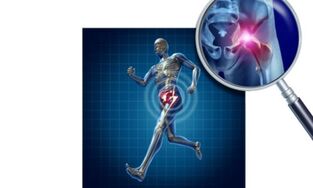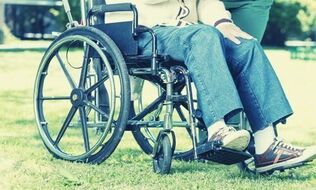Coxarthrosis (osteoarthritis of the hip joint) is a degenerative-dystrophic disease of the hip joints, which is accompanied by damage to the articular cartilage, bone tissue and periarticular structures and leads to a persistent loss of joint function.

Arthrosis of the hip joints is one of the most severe monetary-supported dystrophic pathologies of the musculoskeletal system. The disease quickly leads to a decrease in motor activity, often a change in the nature of a person's movements - the impossibility of independent movement and disability. A few decades earlier, coxarthrosis was seen as one of the "old age diseases". However, since the beginning of this century, there has been a high incidence in young and middle-aged patients for various reasons.
Statistics
Osteoarthritis is the most common pathology of the musculoskeletal system and occurs in 70% of adults. Coxarthrosis - in 25% of patients with an orthopedic profile. Up to 30% of patients diagnosed with coxarthrosis are disabled, given a disability, and require joint replacement surgery.
The disease occurs at the age of 20-25 years, the average age of onset is 37-39 years and progresses with age, which is associated with the presence of comorbidities of the musculoskeletal system, bone loss, etc. In middle-aged patients, the prevalence of coxarthrosis is 11 years%, in people over 85 years - 35%. In children and adolescents, coxarthrosis is a consequence of congenital dysplasia of the joints, which is observed in 1% of newborns.
Reasons for development
The reasons for the development of osteoarthritis of the hip joint have different meanings depending on the age and general health of each patient:
- congenital disorder of the normal anatomical shape of the joints - deformities of the femoral neck, congenital dislocation of the hip;
- Deformation of the femoral head due to dystrophic (age-related) processes in the joint;
- traumatic injuries - fractures, dislocations, non-physiological, including sports, loads on the joints;
- infectious and inflammatory diseases - tuberculosis, osteomyelitis and others;
- rheumatoid arthritis and other systemic diseases (allergic, metabolic);
- When the exact cause of the disease is unknown and has developed on its own, the term "idiopathic coxarthrosis" is used.

Symptoms of coxarthrosis of the hip joint
Pain is the main symptom. Its severity and the addition of other manifestations of coxarthrosis depend on many factors, in particular, body weight, lifestyle, age. In the initial stages, patients notice moderate, intermittent pain in the hip joints, which occurs mainly with physical exertion and occurs on its own. Then the pain begins with light exertion, does not go away at rest, "shoots" into the knee joint. The mobility of the joint or both joints is limited.
Patients are forced to limit physical activity, lameness, "duck walk" appears. In the end stage, unbearable constant pain is observed, mobility in the hip joints is severely limited, walking is only possible with a stick or crutches, patients need support around the clock and are disabled.
Development
As the disease progresses, the hip joint gradually collapses and completely loses its function.
There is a thinning of the articular cartilage and a slight narrowing of the joint space. The bone tissue under the cartilage becomes denser. At this stage, pain occurs after physical exertion.
In the second phase, the destruction of the cartilage proceeds. Marginal osteophytes appear - bone growth. The narrowing of the joint space continues. Pain when walking, restriction of joint mobility (contracture).
In the final stage of coxarthrosis, bone growth is great, the femoral head flattens and subluxates, the joint space practically disappears. Constant severe pain, joint mobility is considerably restricted.

Coxarthrosis diagnostics
If you have groin pain, joint mobility impairment, and other symptoms listed above, you can seek advice from a therapist. However, the leading medical specialist who diagnoses and treats osteoarthritis of the hip joint is an orthopedic traumatologist.
The main method used to diagnose coxarthrosis is radiography. This is an informative method that will allow you to accurately assess the structural changes in the affected joints. Because of its cost-effectiveness and affordability, joint radiography is still very popular. X-ray computed tomography is a more informative (but more expensive) method. Magnetic resonance imaging (MRI) of the joints is also used. It is done to detect coxarthrosis in the pre-X-ray stage (when the X-rays have not yet shown any changes) and for differential diagnosis.
Treatment of coxarthrosis of the hip joint
In the early stages of coxarthrosis with a favorable course of the disease, preference is given to conservative methods using physiotherapy techniques, including kinesiotherapy, massage and physiotherapy, especially water and mud therapy, a physiotherapy complex. Magnetotherapy can also be distinguished among the physiotherapeutic techniques that have proven themselves.
Magnetic field therapy for coxarthrosis is used for various purposes. Regeneration processes are activated under the influence of a magnetic field in the body, and blood circulation is also improved in the bone tissue. The latter point is particularly important because in osteoarthritis the joints are not supplied with enough blood and therefore not enough nutrients are available to maintain the normal condition of cartilage and bone tissue. This can worsen pathological changes in the joint. The improvement of the blood circulation in the area of the hip joints helps to restore the flow of essential nutrients to the joints, activates the metabolism in the bone and cartilage tissue, which forms the basis for the positive effect of magnetotherapy in coxarthrosis.
Due to the improvement in metabolic processes and the release of certain biologically active substances, the anti-inflammatory and analgesic effects of magnetotherapy are also observed.

Diet therapy is recommended to normalize the metabolism and reduce body weight. In addition to a rational diet, aids (drugs and biologically active pharmaceutical additives) can be used that influence the metabolism and the recovery processes in the musculoskeletal system - based on glucosamine and chondroitin (chondroprotectors), minerals and vitamins, standardized plant extracts.
Drugs with anesthetic and anti-inflammatory effects, namely NSAIDs, GCS, muscle relaxants and a few others, are used in all stages of coxarthrosis to relieve pain and inflammation. Their use should be strictly dosed under the supervision and prescription of a doctor.
In the second or third stage of the disease, depending on the symptoms and condition of the patient, it is recommended to continue conservative treatment or surgery. Various surgical methods are currently used, the best results (complete restoration of joint functions and human mobility) being obtained with a full endoprosthetic - replacement of the hip joint.
Drug therapy, nutritional therapy and lifestyle changes, physical therapy and spa treatment are also recommended, both in the case of surgery and in a conservative approach. Physiotherapy techniques in complex treatments can reduce the amount of medication and stress on the body, promote faster recovery after surgery, and improve the patient's general condition. In particular, magnetotherapy shows good effectiveness and tolerance, even in weakened elderly patients and people with chronic diseases of the nervous and cardiovascular system.

Prevention of osteoarthritis of the hip joint
The early detection of coxarthrosis is very important as a preventive measure. If you notice symptoms (pain, limited mobility) in the area of the hip joints, you need to consult a doctor - first you can see a therapist, then definitely an orthopedic surgeon. The therapist can prescribe an initial pain reliever treatment, recommend chondroprotectors, and an orthopedic surgeon will prescribe specific treatment.
The absence of obesity and normal physical activity, the correction of working conditions and lifestyle in general, as well as the timely treatment of diseases that can become one of the causes of the development of coxarthrosis (inflammatory, infectious diseases of the joints, congenital anatomical defectsof the joints, degenerative) dystrophic diseases).







































